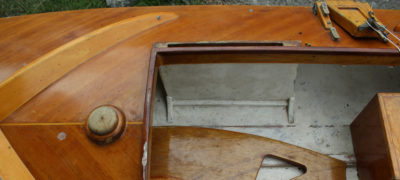When James Kealey built a boat so his sons could learn about perseverance and independence, he gave them something priceless: immersion in an activity at so young an age that they won’t remember learning what to do on a boat, they will just know how to do it. As children, we learn without questioning, and if we’re lucky enough to learn in an unthreatening environment that is patient and encouraging, we learn without inhibition or fear of getting it wrong.
By the time I was 16, I had no memory of a time when I couldn’t sail; it was just a part of life, like walking or talking. I could remember learning some of the finer details, but that was about mastering anticipation—What was the wind going to do? Where was that other boat going to go? It was never about where I should be sitting or how my sails should be set, those were things that just happened.
Then I started teaching at the local sailing school, and for the first time not only did I have to think about the process of moving a boat under sail, I had to explain it. I was at a loss…how do you explain something innate? Fortunately, my students were young, and as is the way with small children, they didn’t seek explanation. When I showed them what to do—push the tiller this way, and the boat will turn that way—they didn’t ask why, they simply followed my lead. A few years later, I graduated to adult students and was faced with a new reality. These learners wanted to understand the whys and the hows.
For me, a still-young instructor, the adults were frustrating: How could they not get this? How could they sit firmly to windward with their boat heeled toward them, even as they subconsciously leaned their bodies into the center of the boat in search of level comfort? How could they not know where the wind was coming from? Or see how the tidal current was affecting their progress? Or not be infuriated by that flapping jib?… And what was with the incessant questioning?
Then, one winter when I was in my mid-20s, I was invited to take downhill skiing lessons, and I became an adult beginner, riddled with insecurity and doubt. Eight-year-olds flashed past me, whooping and hollering with delight as I snow-plowed across the piste like an oversized Bambi on ice; my teacher made effortless, graceful turns as I, unable to get my skis to change direction, again and again came to an abrupt halt in the ungroomed snow at the side of the slope. I didn’t get it, any of it. And the more I struggled, the more I questioned and internally screamed for the hows and the whys. In one of my catching-my-breath moments lying crumpled in a snowbank staring up at the bright alpine sky, I had a sudden flash of admiration for all those mature sailing students I’d known. They had been dropped into an alien environment where their only tool was a ridiculous adult brain that kept getting in the way. And yet, despite that, many of them had actually gotten it and become excellent sailors.
Learning a new skill as an adult is not the easy, unconscious journey that learning to sail will likely be for James Kealey’s sons. Some of us shy away from the challenge, annoyed by the well-meaning but mildly condescending acquaintance who tells us “You’re never too old to learn”; succumbing instead to the inner voice that cautions “You’re too old, you’ll look a fool.” Yet, there are those who prove that it really is never too late. Gary Carbocci graduated from high school in 1969 and launched his first boat in 2024. He’d been thinking about building it for 50 years before he finally decided, seven years ago, that the time had come. He’d never before built a boat, any boat. But he didn’t start with an easy project; instead, he stepped right into the deep end and built a traditionally planked, 16′ Adirondack guideboat with intricate curves and delicate joints. He worked alone, without a mentor or instructor, just a couple of well-written books. But Gary had a desire and a self-confidence that told him “You’re never too old.”![]()













Join The Conversation
We welcome your comments about this article. If you’d like to include a photo or a video with your comment, please email the file or link.